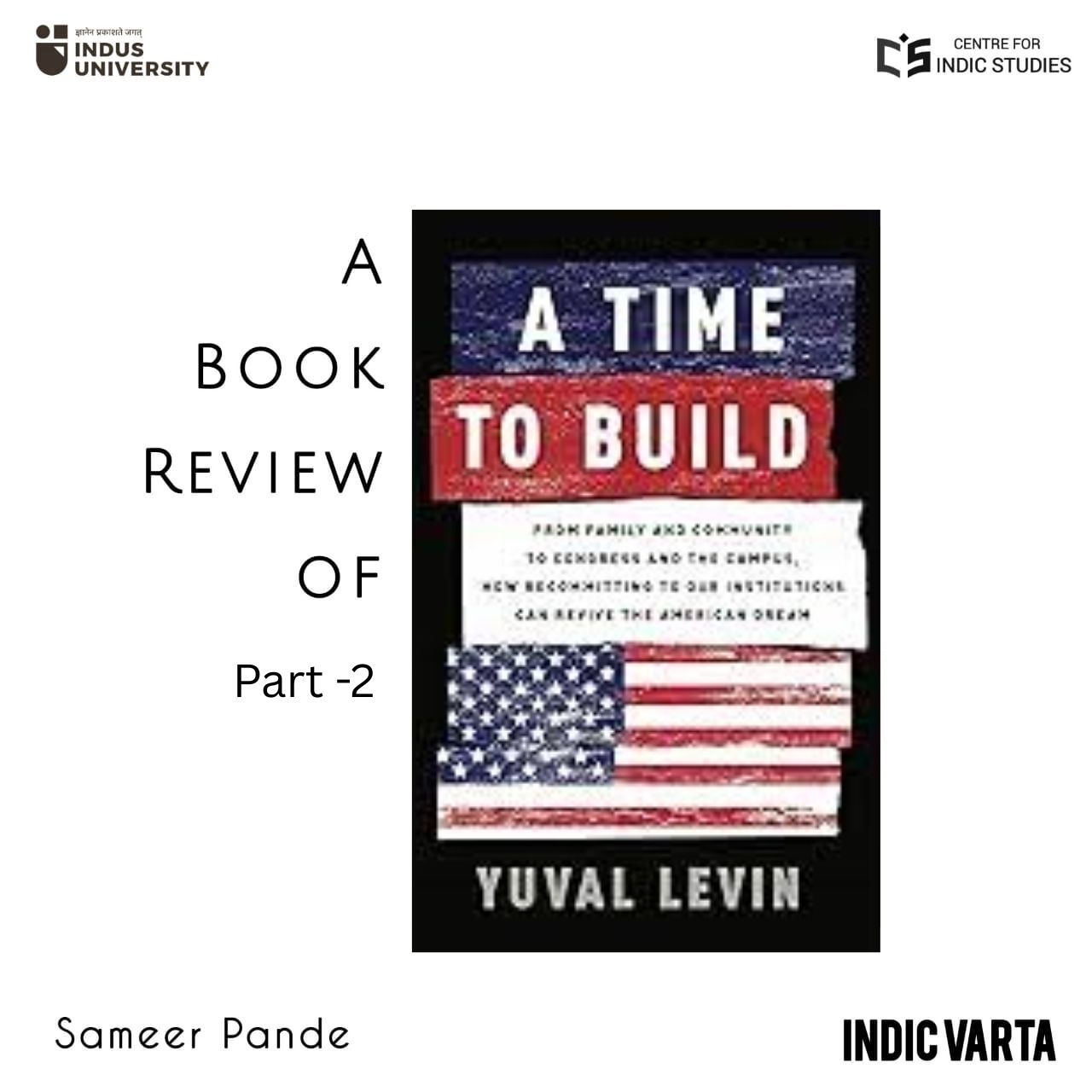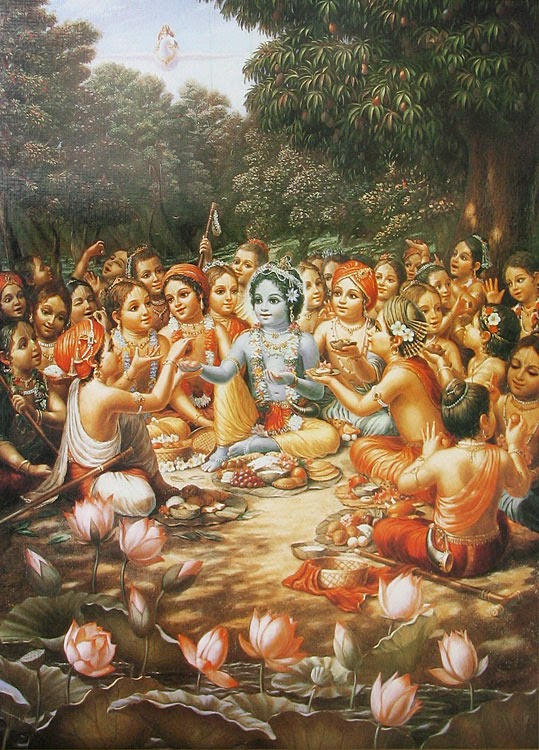- Visitor:57
- Published on: 2025-06-23 10:05 am
Book Analysis of Yuval Levin's 'A TIME TO BUILD' - Part 2
When we know the cracks in the system, we need solutions and at such an instance we must look to the past, the learnings from the surviving civilizations. Yuval Levin presents those cracks which are reviewed in the first part of the book review - what is the solution then? The question revolves around institutions and its working hierarchies, about families and fracturing, about religion, freedom and autonomy. The downfall of America as we observed through his lenses, must also be curated through. Do we Indians have the answer? yes, we do.. but we won’t act as ‘white man is the burden’ theorists.

While reading the next part, I was curious to the question - Do Institutions shape souls or the Souls shape institutions? This cyclical rhythm lies at the heart of every civilization, but what happens when both begin to decay?
In the eighth chapter, The Case for Commitment, of Part Three, Levin tries to build a case for commitment to institutions. But why, we may ask, does a culture so soaked in institutional abundance need to explain their necessity at all? Because America, for all its structure, suffers from anti-institutionalism at its core.
We are so taught in our curriculums that America is great because it is constitutional. Still, we find the same question - America: Institutional Yet Anti-Institutional? Again and again, this contradiction is not accidental, it is civilizational. America was born in revolt, not reverence, a Protestant rejection of the hierarchical, and the inherited. It substituted faith with feelings, structure with spontaneity, and dutiful conformity with authentic expression. Thus, to be “institutionalized” in America is a negative condition, a loss of freedom, autonomy, and individuality. No wonder why the very term “institutional racism” carries real weight, not just because it names a historical injustice, but because it aligns with a deep cultural suspicion of power structures themselves. Here is the same trap that is used over Indian analysis. This is for Indian readers, for me, this framework, which is already imported into Indian academia and has always been and has become a categorical error, a foreign lens smuggled into Indian academia, where “institution” had a wholly different dharmic meaning. India is a culture of embedded institutionalism. Our institutions, family, ashrama, kula, jati, matha, sabha, were not mechanical systems. They were samskaric spaces, designed not just to manage life, but to form it.
Where the Western mind asks, “What do I want?”, The Indic mind is trained to ask, “What is my dharma in this context?” This difference is not semantic. It is civilizational. Where the West sees the individual as prior to the institution, Bharat sees the institution as formative of the self. To be is to be in relation, not in resistance. Levin then discusses the important difference - Populism vs Institutional Rigor. He identifies a danger: populism, unstructured emotion masquerading as political ideology. But this populism thrives not because institutions exist, but because they have failed. He tells us about America's twin diseases, first, overly rigid bureaucracy and second, utter libertarianism which fuels each other. One gives birth to rebellion, the other to anarchy. And in the middle is the broken soul, seeking either escape or spectacle. Hence, the rise of “celebrity feeling” within institutions, be it office, school, or even the church. The institution, once meant to form character, now forms branding. It is no longer about obligation but recognition, a yearning to be seen, be liked, be heard. Even politics today is not a forum of ideas, but an arena of affirmation. Levin is very correct in his analysis and in pointing to short-termism, a modern pathology that amputates memory and future alike. In the Indic tradition, we might understand through the terms such as Karma and Kala which were not metaphysical musings, they were reminders that every action is part of a continuum, embedded in cosmic accountability.
So, the answer to the question for Modern minds which is trapped in recency bias and cannot think across generations. But institutions, real institutions, do exactly that. They are carriers of preconception, as Mary Douglas put it. They are grammars of the long game. Without them, the soul floats. It desires meaning but cannot endure method. Levin gestures toward a “moral longingness”, the hunger to matter, to live with purpose. But this hunger cannot be fed by liberalism’s buffet of choices. It requires commitment, which in turn requires structure, but not cold bureaucratic structure. It requires living institutions that teach duties before demands. Honor, obligation, responsibility, these were once not aspirations but expectations. Where has that world gone? The rise of the crisis of legitimacy, or crisis of civilization?
Today’s social crisis is not just institutional. It is ontological. We do not just distrust systems, Americans no longer know how to belong. They and even us are not forming citizens, we are entertaining consumers. To heal, we must re-sacralize the idea of institutions, not merely as structures of power, but as sacred spaces of self-making. This was the dharmic genius of Bharat: not to destroy the ego, but to form it rightly through structured interdependence. What happens when a system built on “fairness” calcifies into a new form of hierarchy? The answer is in Chapter nine, Beyond Meritocracy, Levin examines how democratic societies, though ostensibly grounded in egalitarian ideals, wrestle perpetually with legitimacy. They wear their claims to authority “on their sleeves” via constitutions, elections, courts, but these formal trappings cannot alone satisfy people’s deeper sense of being recognized, respected, and formed by a shared social philosophy.
Levin takes us to the thought of legitimacy and the distribution of power. He invokes Irving Kristol’s insight: democracy needs more than ballots and markets. The distribution of power, privilege, and property must feel expressive of values that people hold. If the outcomes of politics contradict those values, citizens feel not only unequal but also unfree, regardless of legal guarantees. In other words, legitimacy depends on institutions and elites embodying a believable moral narrative, not merely procedural fairness. This drives a paradox: democratic ideals fuel scrutiny of institutions (“institutionalized racism” being a real phenomenon), but that scrutiny often slides into anti-institutionalism. When people suspect that institutions perpetuate injustice, they reject both the specific abuses and the very idea of enduring structures. Yet tearing down institutions without rebuilding deeper legitimacy only intensifies cynicism and fragmentation. Levin traces the lineage from the old Anglo-Saxon Protestant (WASP) near-aristocracy to the post–mid-century meritocratic ideal. Michael Young’s 1958 critique showed that expanding opportunity beyond birth-right can unleash talent. For a moment, one generation, America seemed to broaden its elite: talent and effort could propel individuals into positions of influence. Yet that opening was fleeting. Over time, meritocracy hardened into a new aristocracy: networks, familial legacies, credential cascades. The rhetoric of “anyone can rise” remains, but in practice the gates close once a new elite is formed. Levin notes that every society has elites; the question is whether those elites answer the duty-laden institutional question: “Given my position here, how should I behave?” If elites fail to demonstrate responsibility, their authority rings hollow. Here Indian Dandaniti comes into the picture to answer the complexities.
Levin invites us to see how meritocracy, in absence of formative institutions, slides from openness to exclusion. The meritocratic credential becomes a barrier: prestigious schools, internships, fellowships, all requiring prior advantage. Thus, the ideals of fairness and mobility give way to entrenchment. While reading about WASP in the book, I take the writer's privilege to discuss a similar term of ‘Boston Brahmins’ and analogies of elite formation. Although Levin does not mention this term, we can draw a parallel: “Boston Brahmins” was a label (sometimes misused or romanticized) for an old New England elite. Like the old Brahmin class in India, it signified social prominence and moral leadership but often concealed exclusionary practices. In the American context, invoking “Boston Brahmins” can illustrate how elites cloak themselves in cultural capital and perpetuate power.
In India, the term “Brahmin” has its own dharmic context, ideally signifying duty and learning rather than mere privilege. Misusing it to describe an elite clique misses the Indic principle that caste (varna) in its original conception was meant to align with swadharma, duty according to one’s nature and context, not hereditary monopoly. This contrast highlights how Western elites sometimes adopt borrowed categories without their original formative ethos, turning “brahmin” into a shorthand for exclusivity rather than service. This is another important insight that we need to understand is the difference between institutionalized elites vs. dharma-informed leadership. Here lies Levin’s deeper concern: elites must persuade people that their authority expresses shared values. In the Indic tradition, leadership hinged on Dharma, leaders (whether kshatriya-rulers, brahmana-scholars, or grihastha-patrons) were bound by duty to the wider order (rta). Their legitimacy derived not from credentials alone but from adherence to norms that served community welfare and cosmic balance.
By contrast, Western meritocratic elites often lack a transcendent organizing principle beyond competition and performance. Hence the restless quest for recognition (“celebrity feeling”) within institutions. The question “How shall I behave given my position?” falls to personal calculation or brand-building, not to an inherited or internalized duty-system. This gap fuels populist backlash: when elites fail to exhibit genuine commitment, the public recoil, accusing them of arrogance or detachment. Levin observes that the mid-20th-century expansion of bureaucracy and professional management promised efficient governance. But in absence of formative norms, bureaucracy becomes self-perpetuating, opaque, and detached. Meritocratic selection for bureaucratic roles may bring competence, yet without a moral compass rooted in institutional purpose, it hardens into credentialism. Officials ask “What’s my next career step?” rather than “How does my role serve the common good?”
Then comes the question of antinomianism and the platformification of character. As in earlier chapters, Levin sees a shift from “molds of character” to “platforms of performance”, where individuals use institutions to showcase their identities, victories, or grievances, rather than to cultivate virtues. This antinomian tendency (rejecting norms) thrives when institutions fail to offer a compelling formation narrative. Meritocratic elites, instead of stewarding institutions, treat them as stages for personal advancement or ideological signaling, deepening the crisis of legitimacy.
Without institutions that inculcate long horizons, societies fall prey to recency bias. Policy debates centre on immediate interests; elites chase the next trend. In Indic thought, time is woven into the moral fabric: actions connect past, present, and future. Elites informed by Dharma consider not only personal gain but intergenerational duty. Western meritocracy, lacking that dimension, struggles to sustain long-term commitments, weakening its claim to authority. Levin hints at a longing for a principle that transcends procedural fairness: a unifying ethos or “social philosophy” persuasive enough to bind people. In India, Dharma historically played that role, ordering relations, duties, and institutions. Today, the West flirts with various substitutes: “social justice,” identity frameworks, or market ideology, none fully satisfying the deeper hunger for meaning and stable legitimacy. Levin does not prescribe Dharma explicitly, but his critique points toward a need for a comparable organizing principle: something that grounds meritocratic selection in service, transforms institutions into vessels of formation, and persuades citizens that power distribution truly resonates with shared values.
Conclusion of the book
Yuval Levin concludes not merely with critique, but with a diagnosis that cuts through the cultural fog: a collapse of responsibility, an erosion of trust, a spectacle-driven political culture, and the psychological havoc wrought by social media’s distortive mirror. He mourns the institutional vacuum left behind by a celebrity-saturated cynicism that celebrates demolition over construction, outrage over order. And yet, amid the rubble, Levin plants a seed of radical hope, what if we chose to rebuild? What if, instead of lamenting the loss of rootedness, we cultivated it anew by seeing institutions not as constraints, but as vessels of meaning? All Yuval Levin’s work will be concluded in the next and last article on Yuval Levin’s work. This will include the crux of all the three books. This will include what we must learn from him but also how to look at this civilizational question from an Indic background and our own grammar.
- 28 min read
- 2
- 0










